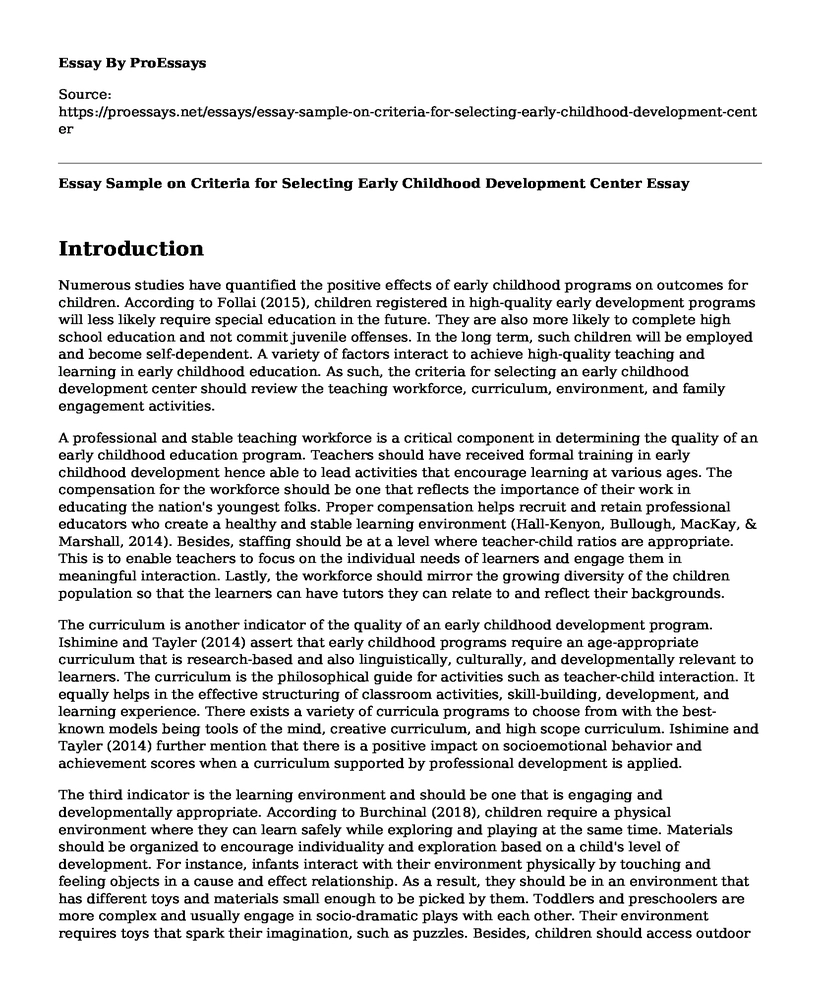Introduction
Numerous studies have quantified the positive effects of early childhood programs on outcomes for children. According to Follai (2015), children registered in high-quality early development programs will less likely require special education in the future. They are also more likely to complete high school education and not commit juvenile offenses. In the long term, such children will be employed and become self-dependent. A variety of factors interact to achieve high-quality teaching and learning in early childhood education. As such, the criteria for selecting an early childhood development center should review the teaching workforce, curriculum, environment, and family engagement activities.
A professional and stable teaching workforce is a critical component in determining the quality of an early childhood education program. Teachers should have received formal training in early childhood development hence able to lead activities that encourage learning at various ages. The compensation for the workforce should be one that reflects the importance of their work in educating the nation's youngest folks. Proper compensation helps recruit and retain professional educators who create a healthy and stable learning environment (Hall-Kenyon, Bullough, MacKay, & Marshall, 2014). Besides, staffing should be at a level where teacher-child ratios are appropriate. This is to enable teachers to focus on the individual needs of learners and engage them in meaningful interaction. Lastly, the workforce should mirror the growing diversity of the children population so that the learners can have tutors they can relate to and reflect their backgrounds.
The curriculum is another indicator of the quality of an early childhood development program. Ishimine and Tayler (2014) assert that early childhood programs require an age-appropriate curriculum that is research-based and also linguistically, culturally, and developmentally relevant to learners. The curriculum is the philosophical guide for activities such as teacher-child interaction. It equally helps in the effective structuring of classroom activities, skill-building, development, and learning experience. There exists a variety of curricula programs to choose from with the best-known models being tools of the mind, creative curriculum, and high scope curriculum. Ishimine and Tayler (2014) further mention that there is a positive impact on socioemotional behavior and achievement scores when a curriculum supported by professional development is applied.
The third indicator is the learning environment and should be one that is engaging and developmentally appropriate. According to Burchinal (2018), children require a physical environment where they can learn safely while exploring and playing at the same time. Materials should be organized to encourage individuality and exploration based on a child's level of development. For instance, infants interact with their environment physically by touching and feeling objects in a cause and effect relationship. As a result, they should be in an environment that has different toys and materials small enough to be picked by them. Toddlers and preschoolers are more complex and usually engage in socio-dramatic plays with each other. Their environment requires toys that spark their imagination, such as puzzles. Besides, children should access outdoor space and interact with the natural world. Outdoor play is vital in health and can help in developing stronger immune and combating obesity.
Lastly, a high-quality program recognizes comprehensive family engagement activities. Families are essential to their child's academic success. Consequently, a center with appropriate policies in place that engages the family is a quality indicator. Programs should encourage the participation of families in their child's learning. Two-way communication should be enabled in that parents can share the progress noted on their children (Ma, Shen, Krenn, Hu, & Yuan, 2016). Engaging the family in a reciprocal and comprehensive manner helps providers understand the values and culture of a specific family which can be crucial in coming up with culturally responsive learning experiences. Besides, engaging families build a positive relationship that can help in addressing any concerns.
Conclusion
In conclusion, quality early childhood education is indispensable. The interaction and experiences children have in their early years affect their development and help establish a basis for future learning. The elements discussed above make up the key indicators of a high-quality program. To achieve this excellence early childhood programs, need to access structures that support the policies. While the pathway of each program is unique, they represent the core indicators of quality early childhood education.
References
Burchinal, M. (2018). Measuring early care and education quality. Child Development Perspectives, 12(1), 3-9. Retrieved from https://inid.gse.uci.edu/files/2011/03/burchinal-.pdf
Follari, L. (2015). Foundations and best practices in early childhood education: History, theories, and approaches to learning. Pearson Higher Education AU.
Hall-Kenyon, K. M., Bullough, R. V., MacKay, K. L., & Marshall, E. E. (2014). Preschool teacher well-being: A review of the literature. Early Childhood Education Journal, 42(3), 153-162. doi:10.1007/s10643-013-0595-4
Ishimine, K., & Tayler, C. (2014). Assessing quality in early childhood education and care. European Journal of Education, 49(2), 272-290. doi:10.1111/ejed.12043
Ma, X., Shen, J., Krenn, H. Y., Hu, S., & Yuan, J. (2016). A meta-analysis of the relationship between learning outcomes and parental involvement during early childhood education and early elementary education. Educational Psychology Review, 28(4), 771-80. doi:10.1007/s10648-015-9351-1
Cite this page
Essay Sample on Criteria for Selecting Early Childhood Development Center. (2022, Mar 15). Retrieved from https://proessays.net/essays/essay-sample-on-criteria-for-selecting-early-childhood-development-center
If you are the original author of this essay and no longer wish to have it published on the ProEssays website, please click below to request its removal:
- Linguistic Principle Explaining to the Local Group of ASL Teachers
- Introducing Problem Based Learning to the University
- Summary of Read-Only Participants: A Case for Student Communication in Online Classes
- 1960s-70s New Left: Activists Fighting for Social Change - Essay Sample
- Essay Sample on Early Childhood Education: Playtime for Fun or Control?
- Essay on Body Safety Education: Essential for Schools to Protect Children from Sexual Abuse
- Students: Overcoming Procrastination Addiction - Essay Sample







